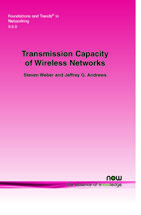Transmission Capacity of Wireless Networks
By Steven Weber, Drexel University, USA, sweber@coe.drexel.edu | Jeffrey G. Andrews, The University of Texas at Austin, USA, jandrews@ece.utexas.edu
Abstract
Transmission capacity (TC) is a performance metric for wireless networks that measures the spatial intensity of successful transmissions per unit area, subject to a constraint on the permissible outage probability (where outage occurs when the signal to interference plus noise ratio (SINR) at a receiver is below a threshold). This volume gives a unified treatment of the TC framework that has been developed by the authors and their collaborators over the past decade. The mathematical framework underlying the analysis (reviewed in Section 2) is stochastic geometry: Poisson point processes model the locations of interferers, and (stable) shot noise processes represent the aggregate interference seen at a receiver. Section 3 presents TC results (exact, asymptotic, and bounds) on a simple model in order to illustrate a key strength of the framework: analytical tractability yields explicit performance dependence upon key model parameters. Section 4 presents enhancements to this basic model — channel fading, variable link distances (VLD), and multihop. Section 5 presents four network design case studies well-suited to TC: (i) spectrum management, (ii) interference cancellation, (iii) signal threshold transmission scheduling, and (iv) power control. Section 6 studies the TC when nodes have multiple antennas, which provides a contrast vs. classical results that ignore interference.
Transmission Capacity of Wireless Networks
Transmission Capacity of Wireless Networks presents a framework for computing the outage probability (OP) and transmission capacity (TC) in a wireless network. Transmission capacity is a performance metric for wireless networks that measures the spatial intensity of successful transmissions per unit area, subject to a constraint on the permissible outage probability (where outage occurs when the SINR at a receiver is below a threshold). This volume gives a unified treatment of the TC framework that has been developed by the authors and their collaborators over the past decade. The mathematical framework underlying the analysis is stochastic geometry: Poisson point processes model the locations of interferers, and (stable) shot noise processes represent the aggregate interference seen at a receiver. Transmission Capacity of Wireless Networks presents TC results (exact, asymptotic, and bounds) on a simple model in order to illustrate a key strength of the framework: analytical tractability yields explicit performance dependence upon key model parameters. It goes on to present enhancements to this basic model - channel fading, variable link distances, and multi-hop. Ch. 5 presents four network design case studies well-suited to TC: i) spectrum management, ii) interference cancellation, iii) signal threshold transmission scheduling, and iv) power control. Ch. 6 studies the TC when nodes have multiple antennas, which provides a contrast vs. classical results that ignore interference. Transmission Capacity of Wireless Networks is essential reading for anyone with an interest in wireless network design and in understanding the fundamentals of the performance and behavior of such networks.
